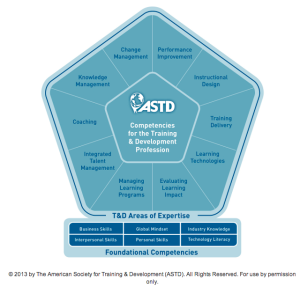 The American Society for Training and Development (ASTD) has maintained a competency model for learning professionals for 30 years. Until this month, the last major update was released in 2004. The world, much less the training profession, has changed much since then, with a continual growth and focus on technology. But it’s not just the inclusion of technology, but a stronger emphasis on being able to identify WHEN technology is appropriate and WHICH technology should be used (aka Digital Literacy). As someone who’s chosen this as my career path, it’s seemed a little odd that it’s not recognized as an official field within the profession, but almost every article cover in T&D, Learning Magazine, and other industry publications is focused on a technology or how technology is impacting learning. So that’s why I was excited when I saw an addition to the competency model Areas of Expertise:
The American Society for Training and Development (ASTD) has maintained a competency model for learning professionals for 30 years. Until this month, the last major update was released in 2004. The world, much less the training profession, has changed much since then, with a continual growth and focus on technology. But it’s not just the inclusion of technology, but a stronger emphasis on being able to identify WHEN technology is appropriate and WHICH technology should be used (aka Digital Literacy). As someone who’s chosen this as my career path, it’s seemed a little odd that it’s not recognized as an official field within the profession, but almost every article cover in T&D, Learning Magazine, and other industry publications is focused on a technology or how technology is impacting learning. So that’s why I was excited when I saw an addition to the competency model Areas of Expertise:
Learning Technologies
Apply a variety of learning technologies to address specific learning needs.
Be able to:
- Use technology effectively across the different areas of expertise
- Identify when and how to use technology as a training and development solution
Personally, I like to know that my field in particular is recognized. More importantly, I think it’s worth noting that technology has made it into the model as a foundational competency (“Technology Literacy”) and a few other competencies for different Areas of Expertise, highlights below:
Instructional Design (renamed from “Designing Learning):
- Analyze and select technologies
- Integrate technology options
Knowledge Management:
- Encourage collaboration
- Facilitate social learning
- Support the development of a knowledge management infrastructure
- Leverage technology
- Design and implement knowledge management solutions
One final note, it’s almost time to start working on 2013 development plans. I would encourage you to take a peek at the model (found at astd.org/model), review the 10 areas of expertise, many of which mirror roles within our organization, and the 6 foundational competencies. There are some job aids to help apply the competencies to you or your team.